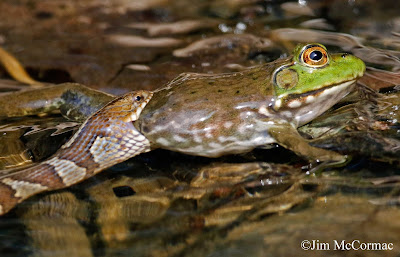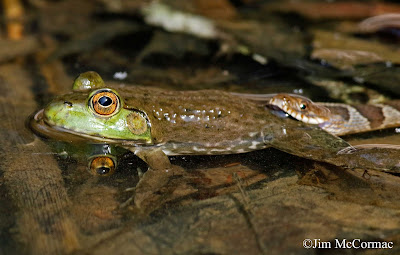The view from the observation tower at Glacier Ridge Metropark, just west of Columbus. This, for me, is a local hotspot, being only 10-15 minutes from home, depending on traffic. But as is so often the case, I all too often shun local patches for places further afield and seemingly more exotic. Well, the deluges finally blew out last Saturday night and Sunday dawned with the promise of a dry day. I only had the morning to shoot, so what the heck thought I, I'll see what Glacier Ridge has to offer.
A lot, as it turned out. I scarcely left the meadow I started in, and within two hours tallied about 55 species, including some goodies. Nearly the first bird out of the chute was a Blue Grosbeak, singing away. That's a rarity in my neck of the woods. A platoon of Bobolinks gurgled their R2-D2-like melodies, and the dry trill of a Grasshopper Sparrow added ambience. Competing Willow Flycatchers loudly upchucked their sneezy FITZ-BEWS! Row houses of bluebird condos sported lots of Tree Swallows, which constantly issued pleasing liquid gurgles, and of course the Eastern Bluebirds provided pleasant husky warbles.
I threw the camera rig together, and stalked the perimeter of the meadow to see what I could photograph.
Before I even got out of the parking lot, my attention was drawn to the loud cheery whistles of an Eastern Meadowlark, teed up on an oak sapling. I greatly enjoy these quailish blackbirds, and began to move in his direction in the hope of obtaining some shots. Shortly after locking him in the Canon's sights, to my surprise a Red-winged Blackbird flew in and nearly landed on the lark. The shot above was taken right after the red-wing alit, and the meadowlark seems to be looking askance at the interloper.
Best as I could tell, the red-wing was only a foot or so away from the meadowlark, and just behind it from my perspective. That's why I could only get decently sharp images of the lark, as that's where I wanted my focus to be.
The meadowlark wasted no time in showing the red-wing who the king of the flutelike whistle is. While the lark had been singing before the blackbird arrived, its appearance seemed to prod him to greater musical heights. Senor red-wing listens, but does not seem impressed.
Once the lark clammed up, the red-wing puffed out his scarlet epaulets and let loose with a throaty CONK-AH-REE-ONK! It was as if he was telling lemon-boy who's the boss in this meadow.
Well! That last red-wing aria seemed to ruffle the meadowlark's feathers a bit, and moments after I took this shot he fluttered from the tree. While the dueling blackbirds' performance didn't last long, I was glad to be there to enjoy the interaction.
A lot, as it turned out. I scarcely left the meadow I started in, and within two hours tallied about 55 species, including some goodies. Nearly the first bird out of the chute was a Blue Grosbeak, singing away. That's a rarity in my neck of the woods. A platoon of Bobolinks gurgled their R2-D2-like melodies, and the dry trill of a Grasshopper Sparrow added ambience. Competing Willow Flycatchers loudly upchucked their sneezy FITZ-BEWS! Row houses of bluebird condos sported lots of Tree Swallows, which constantly issued pleasing liquid gurgles, and of course the Eastern Bluebirds provided pleasant husky warbles.
I threw the camera rig together, and stalked the perimeter of the meadow to see what I could photograph.
Before I even got out of the parking lot, my attention was drawn to the loud cheery whistles of an Eastern Meadowlark, teed up on an oak sapling. I greatly enjoy these quailish blackbirds, and began to move in his direction in the hope of obtaining some shots. Shortly after locking him in the Canon's sights, to my surprise a Red-winged Blackbird flew in and nearly landed on the lark. The shot above was taken right after the red-wing alit, and the meadowlark seems to be looking askance at the interloper.
Best as I could tell, the red-wing was only a foot or so away from the meadowlark, and just behind it from my perspective. That's why I could only get decently sharp images of the lark, as that's where I wanted my focus to be.
The meadowlark wasted no time in showing the red-wing who the king of the flutelike whistle is. While the lark had been singing before the blackbird arrived, its appearance seemed to prod him to greater musical heights. Senor red-wing listens, but does not seem impressed.
Once the lark clammed up, the red-wing puffed out his scarlet epaulets and let loose with a throaty CONK-AH-REE-ONK! It was as if he was telling lemon-boy who's the boss in this meadow.
Well! That last red-wing aria seemed to ruffle the meadowlark's feathers a bit, and moments after I took this shot he fluttered from the tree. While the dueling blackbirds' performance didn't last long, I was glad to be there to enjoy the interaction.




































































